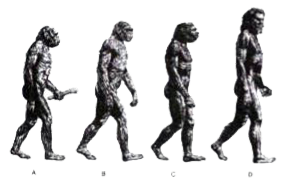The extinct human ancestor, who ate only fruits and hunted with stone weapons was
(a) Ramapithecus
(b) Australopithecus
(c) Dryopithecus
(d) Homo erectus
Dryopithecus
Australopithecus
Homo Erectus
Ramapithecus
The correct Answer is:B
Step by step video & image solution for The extinct human ancestor, who ate only fruits and hunted with stone weapons was (a) Ramapithecus (b) Australopithecus (c) Dryopithecus (d) Homo erectus by Biology experts to help you in doubts & scoring excellent marks in Class 12 exams.
Updated on:21/07/2023Topper's Solved these Questions
- ORIGIN & EVOLUTION OF LIFEBOOK - ALLENCHAPTER - ORIGIN & EVOLUTION OF LIFEEXERCISE - EXERCISE-III A(NCERT BASED QUESTIONS)
70 Videos
- ORIGIN & EVOLUTION OF LIFEBOOK - ALLENCHAPTER - ORIGIN & EVOLUTION OF LIFEEXERCISE - EXERCISE-III B(ANALYTICAL QUESTIONS)
35 Videos
- ORIGIN & EVOLUTION OF LIFEBOOK - ALLENCHAPTER - ORIGIN & EVOLUTION OF LIFEEXERCISE - EXERCISE-I (HUMAN EVOLUTION)
29 Videos
- ORIGIN & EVOLUTIONBOOK - ALLENCHAPTER - ORIGIN & EVOLUTIONEXERCISE - S
65 Videos
- PHOTOSYNTHESIS IN HIGHER PLANTSBOOK - ALLENCHAPTER - PHOTOSYNTHESIS IN HIGHER PLANTSEXERCISE - Match the column
3 Videos
Similar Questions
The two human ancestors who belonged to the species of Homo erectus are
(a) Dryopithecus and Ramapithecus
(b) Ramapithecus and Java man
(c) Java man and Peking man
(d) Neanderthal man and Cro-magnon man
View SolutionThe correct sequence of human ancestors in increasing brain capacities.
a. Neanderthal man b. H. erectus
c. Cromagnon man d. H. habilis
e. Australopithecus
View Solution
Knowledge Check
The extinct human ancestor, who are only fruits and hunted with stone weapons was
ARamapithecusBAustralopithecusCDryopithecusDHomo erectus.Match column I with Column II and select the correct option from the codes given below.
Column IColumn IIEdward Lewis(i)AustralopithecusL.S.B. Leakey(ii)Homo neanderthalensisC. Fuhlrott(iv)RamapithecusAiv,iii,ii,iBii,i,iv,iiiCiii,ii,i,ivDi,ii,iii,iv
Find out the correct pair.
(a) About 15 mya , Australopithecus were probably lived in African grassland and were essentially ate fruit.
(b) The first human like being the hominid was called Homo erectus with capacity 650 - 800cc.
(c) Between 1,00,00 - 40,00 years back, the Neanderthal man were evolved which were brain size of 1400cc.
(d) The skull of body human is more like adult chimpanzee skull than adult human skull.
View SolutionRead four statements about hominid species:
(a) Agriculture and human settlements started about 18000 years ago.
(b) Cave art developed approximately 10000 years ago.
(c) Homo sapiens arose in Africa.
(d) Homo erectus existed about 1.5 million years ago.
how many statements are correct among these?
View SolutionRead the following statements about the evolution of man and choose the option which correctly states true ((T)) or false ((F)):
(A.) The first human-like being the hominid was called Homo erectus with cranial capacities between 650-800 cc.
(B.) The cranial capacity of modern man is closer and similar to Neanderthal man.
(C.) During ice age 1,00,00-40,000 years ago, modern Homo sapiens arose.
(D.) The skull of an adult chimpanzee is more like a baby human skull.
View SolutionRead the following points.
a. Cranial capacity about 900 c.c.
b. Probably ate meat.
c. First prehistoric man to make use of fire. These points are true for:
1) Homo habilis
2) Homo erectus
3) Homo sapiens fossils
4) Homo sapiens neanderthalensis
View SolutionCarefully observe the figure and then answer the questions that follow :
 (i) Identify the ancestors of humans shown in the figure.
(i) Identify the ancestors of humans shown in the figure.
(ii) Write any two characters of each A and C.
(iii) What is the cranial capacity of B ?
(iv) What is the height of D ?
(v) What type of teeth does D had ?
View SolutionRead the following statement A) 6th mass extinction species is being caused anthropogenically and is 10 time faster than the rate of natural extinctions. B) passenger pigeon have become extinct due to over Exploitations of humans. C) Norway has lower ecosystem diversity than India. D) more than 50000 varieties of mango occur in India. choose the option with correct sets of statement
View Solution
